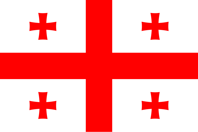Become GEOrGIAN
IT’S TIME TO
DIVE INTO A LIFESTYLE
From its founding in 337 AD by the Kingdom of Iberia, through its golden age in the medieval Georgian kingdom, Georgia has played a central role in the history of the Caucasus and beyond. Its rich cultural tapestry reflects influences from Greek, Persian, Byzantine, and Russian rule, seamlessly blended with deeply rooted Georgian traditions. With its stunning architectural heritage, from ancient monasteries carved into cliffs to Tbilisi's vibrant old town, Georgia offers a timeless journey through its dynamic and enduring cultural legacy.
After regaining independence from the Soviet Union in 1991, Georgia underwent a remarkable transformation. The nation embraced democratic and economic reforms, striving for European integration while preserving its unique identity. With a thriving wine industry, world-renowned polyphonic music, and rapidly growing tourism sector, Georgia showcases a country that honors its past while shaping a bright future. Today, Georgia stands as a gateway between Europe and Asia, celebrated for its distinct language, rich cuisine, and unwavering spirit of resilience.
We have created a selection of words and expressions that you won't find in any textbook or course, designed to make you feel like a true native by helping you understand Georgian words with deep cultural significance, while expanding your knowledge of the country and its rich history.
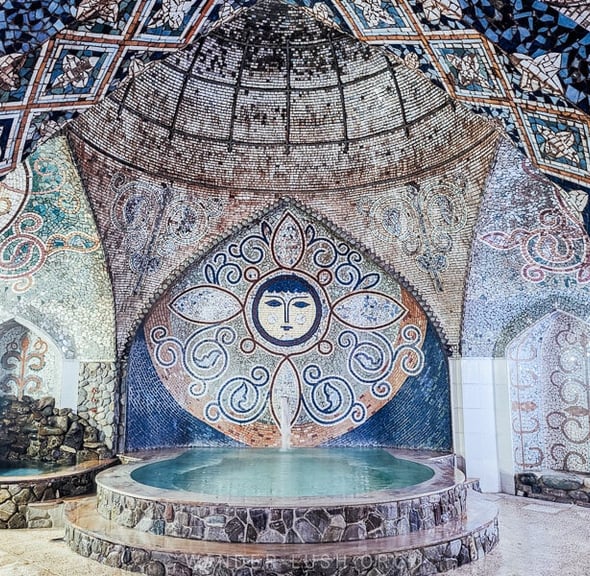

EXPAND YOUR KNOWLEDGE
If you are interested in learning more about Georgian culture and history as well as the language, we recommend that you download our complete Georgian language course!
You will not only receive all the contents available on our website in convenient pdf or epub formats but also additional contents, including bonus vocabulary, more grammar structures and exclusive cultural insights with additional Georgian vocabulary that you won't find anywhere else.
The additional articles include over 100 words or expressions related to the culture of the Georgian people. Not only will you be able to speak the Georgian language with confidence but you will amaze your listeners thanks to your knowledge of their country and history.
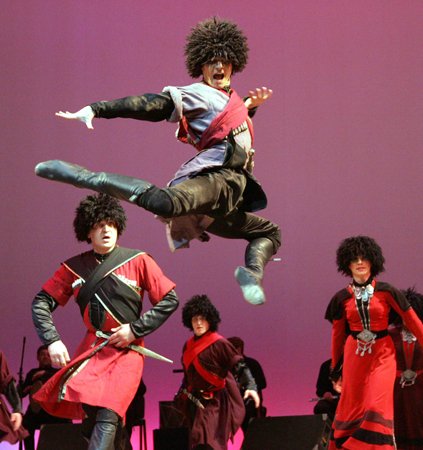

GEORGIAN DANCING
Georgian ტრადიციული ცეკვა (traditsiuli cekva, traditional dance) is one of the most visually striking and energetic folk dance traditions in the world, reflecting the country’s history, values, and warrior spirit. Each region has its own distinctive style, such as კახური ცეკვა (kakhuri cekva, Kakhetian dance), which features strong and dignified movements representing the pride of Georgian men, and სვანური ცეკვა (svanuri cekva, Svan dance), which is performed with swords and shields, symbolizing the warrior culture of the highland Svans. One of the most famous and breathtaking performances is ხანჯლური (khanjluri, Khanjluri), where male dancers showcase their agility and bravery by performing acrobatics while balancing daggers. In contrast, აჭარული ცეკვა (ach’aruli cekva, Adjarian dance) is known for its graceful and flirtatious movements, often performed in colorful costumes. Another iconic dance, ქართული (kartuli, Kartuli), is a romantic duet where the male dancer moves with respect and admiration towards his partner, demonstrating chivalry.


POLYPHONIC SINGING
Georgian პოლიფონიური სიმღერა (poliponiuri simghera, polyphonic singing) is one of the most unique and ancient musical traditions in the world, recognized by UNESCO as an არამატერიალური კულტურული მემკვიდრეობა (aramaterialuri kulturuli memkvidreoba, Intangible Cultural Heritage). This form of singing consists of multiple independent vocal lines, creating a rich and layered harmony. The tradition varies by region, with სვანური სიმღერები (svanuri simgherebi, Svan songs) being some of the most ancient, often featuring deep bass voices and haunting melodies. In contrast, კახური პოლიფონია (kakhuri polifonia, Kakhetian polyphony) is characterized by a leading melody accompanied by a sustained drone. Another remarkable style is found in გურული კრიმანჭული (guruli krimanchuli, Gurian krimanchuli), which includes an intricate yodeling technique that adds an extraordinary dimension to the performance. The მრავალხმიანობა (mravalxmianoba, polyphony) of Georgia is deeply tied to its history, religious traditions, and social gatherings, often performed during სუფრა (supra, feast), weddings, and religious ceremonies.
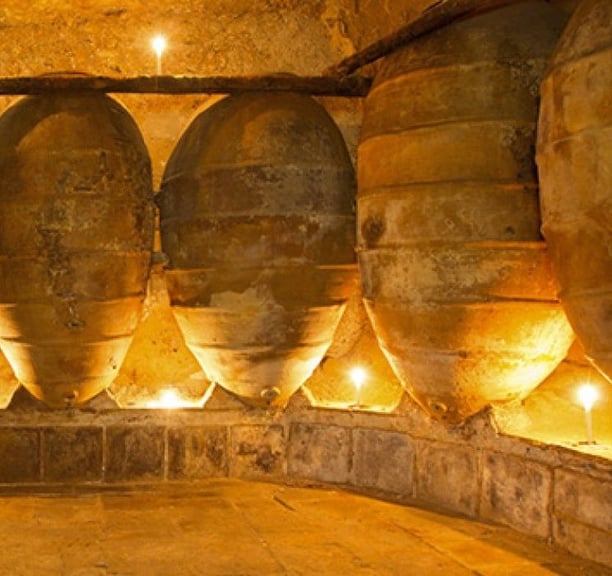

QVEVRI
The ქვევრი (kvevri, qvevri) is an ancient Georgian clay vessel used for ღვინის დაყენება (ghvinis dagekneba, winemaking), a tradition that dates back over 8,000 years and is recognized by UNESCO as part of the არამატერიალური კულტურული მემკვიდრეობა (aramaterialuri kulturuli memkvidreoba, Intangible Cultural Heritage). These large, egg-shaped vessels are buried underground to provide a natural and stable environment for fermentation and aging. The ქვევრის ღვინო (kvevris ghvino, qvevri wine) is unique for its rich taste, natural production process, and deep amber color, especially in თეთრი ღვინო (tetri ghvino, white wine), which undergoes skin contact fermentation. The კახური მეთოდი (kakhuri metodi, Kakhetian method) of winemaking, common in Georgia’s კახეთი (kakheti, Kakheti), involves leaving the grape skins, stems, and seeds in the qvevri for months, enhancing the wine’s complexity. The ქვევრის დამზადება (kvevris damzadeba, qvevri-making) is a highly specialized craft, with master potters carefully shaping and firing these clay vessels. Many traditional Georgian wineries, known as მარანი (marani, wine cellar), still use qvevris, preserving this ancient technique.


BATUMI
ბათუმი (batumi, Batumi) is Georgia’s vibrant შავი ზღვის საკურორტო ქალაქი (shavi zghvis sakurorto kalaki, Black Sea resort city), known for its mix of მოდერნული ცათამბჯენები (modernuli ts’at’ambj’enebi, modern skyscrapers), lively nightlife, subtropical climate, and rich history. As the capital of the აჭარის ავტონომიური რესპუბლიკა (ach’aris avt’onomiuri respublika, Autonomous Republic of Adjara), Batumi is a cultural and economic hub with a unique character shaped by both Georgian and Ottoman influences. The city’s stunning ბათუმის ბულვარი (batumis bulvari, Batumi Boulevard), stretching along the coastline, is perfect for walking, cycling, and enjoying seaside cafes. One of its most iconic landmarks is the ალი და ნინოს ქანდაკება (ali da ninos k’andak’eba, Ali and Nino statue), a moving sculpture symbolizing eternal love. Batumi is also home to the ბათუმის ბოტანიკური ბაღი (batumis botanikuri baghi, Batumi Botanical Garden), one of the most diverse botanical gardens in the world, offering breathtaking views over the Black Sea.
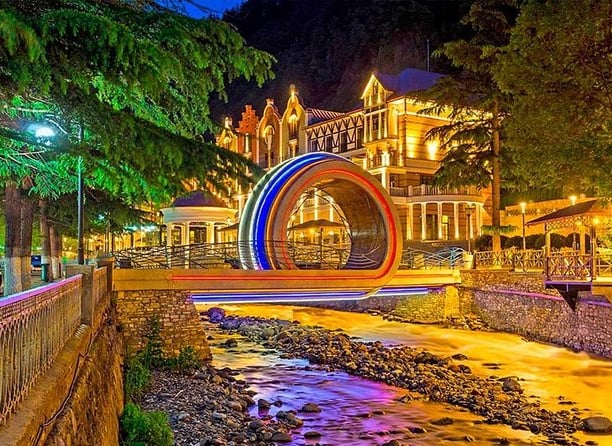

BORJOMI WATER
ბორჯომის წყალი (borjomis ts’kali, Borjomi water) is Georgia’s most famous მინერალური წყალი (mineraluri ts’kali, mineral water), renowned for its unique taste and natural health benefits. Sourced from the ბორჯომის ხეობა (borjomis kheoba, Borjomi Gorge), this naturally carbonated water originates from deep underground springs and is enriched with მინერალები და მიკროელემენტები (mineralebi da mikroelementebi, minerals and microelements) as it passes through layers of volcanic rock. Historically, ბორჯომი (borjomi, Borjomi) was highly prized by ცარისტული რუსეთის არისტოკრატია (tsaristuli rusetis aristokratia, the aristocracy of Tsarist Russia), who considered it a luxurious remedy for digestion and overall well-being. Today, it remains an essential part of ქართული კულტურა (kartuli kultura, Georgian culture) and is often served during a სუფრა (supra, traditional feast), especially after enjoying rich Georgian dishes. The ბორჯომის ეროვნული პარკი (borjomis erovnuli parki, Borjomi National Park) is one of the largest protected areas in Europe, preserving the pristine nature that nourishes this legendary water.
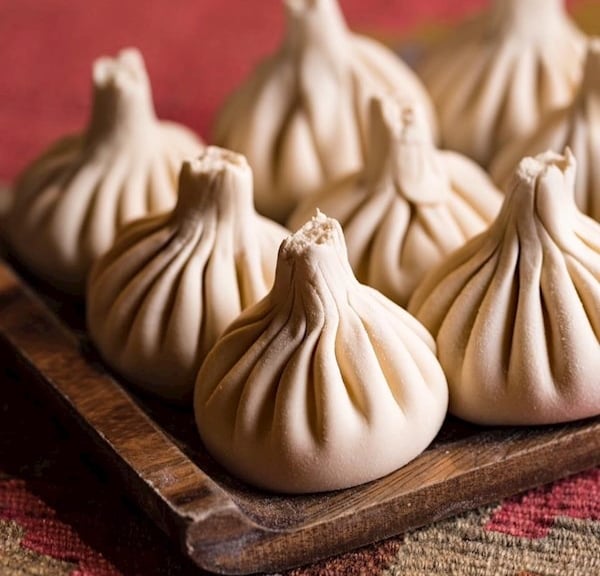

KHINKALI
ხინკალი (khinkali, khinkali) is one of Georgia’s most beloved and iconic traditional dishes, originating from the მთიანი რეგიონები (mtiani regionebi, mountainous regions) such as ფშავი (pshavi, Pshavi), ხევსურეთი (khevsureti, Khevsureti), and თუშეთი (tusheti, Tusheti). These ქართულო პელმენი (kartuli pelmeni, Georgian dumplings) are made by filling dough with a juicy mixture of meat, usually საქონლის და ღორის ხორცი (saqonlis da ghoris khortsi, beef and pork), seasoned with პილპილი და სუნელები (pilpili da sunelebi, pepper and spices). The key to eating khinkali properly is holding it by the ყელი (qeli, top knot), taking a small bite, and drinking the flavorful ბულიონი (bulioni, broth) inside before finishing the dumpling. There are also variations such as მწვანე ხინკალი (mtsvane khinkali, herb khinkali), made with fresh coriander and parsley, and კარტოფილის ხინკალი (kartofilis khinkali, potato khinkali), popular among vegetarians. In Georgia, khinkali is often enjoyed at a traditional სუფრა (supra, feast), accompanied by არაყი (araq’i, chacha) or beer. The best khinkali is found in the მთის რესტორნები (mtis restornebi, mountain restaurants), where generations have perfected the art of making them.

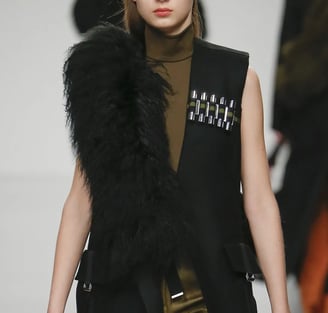
CHOKHA
The ჩოხა (chokha, chokha) is a traditional Georgian garment that has been worn for centuries and remains a powerful symbol of ქართული კულტურული მემკვიდრეობა (kartuli kulturuli memkvidreoba, Georgian cultural heritage). Historically, the chokha was the preferred attire of ქართველი მეომრები (kartveli meomrebi, Georgian warriors), არისტოკრატები (aristokratebi, aristocrats), and even მეფეები (mepeebi, kings), reflecting strength, dignity, and national pride. The design is both practical and elegant, with a მჭიდრო სილუეტი (mtsidro silueti, fitted silhouette), long sleeves, and distinctive ქამარი (qamari, belt), which traditionally held ხანჯალი (khanjali, dagger). The most recognizable feature of the chokha is the ვაზირული ჩანთები (vaziruli chantebi, cartridge holders) sewn onto the chest, originally used for carrying gunpowder charges. Different regions of Georgia have their own variations, such as the სვანური ჩოხა (svanuri chokha, Svan chokha) and კახური ჩოხა (kakhuri chokha, Kakhetian chokha), each with unique colors and decorations. Today, the chokha is often worn during ეროვნული დღესასწაულები (erovnuli dghesastsaulebi, national celebrations), ქორწილები (qorwilebi, weddings), and important public events, serving as a proud emblem of ქართული იდენტობა (kartuli identoba, Georgian identity).
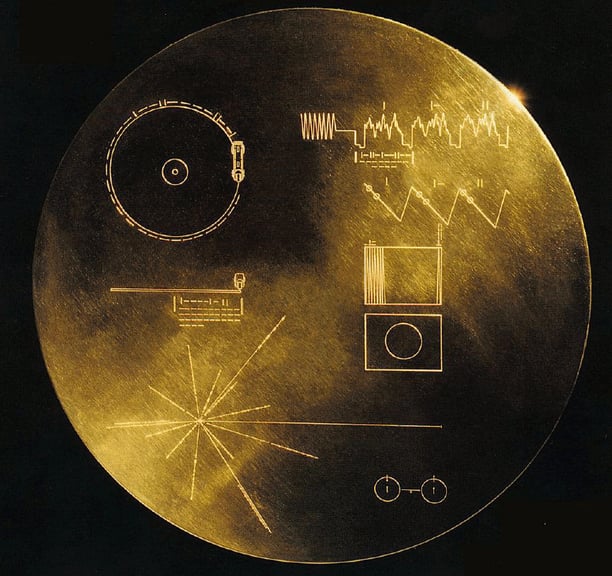

CHAKRULO
ჩაკრულო (chakrulo, Chakrulo) is one of the most famous examples of ქართული ხალხური სიმღერა (kartuli khalkhuri simghera, Georgian folk song) and a masterpiece of მრავალხმიანობა (mravalxmianoba, polyphony). This song, originating from the კახეთი (kakheti, Kakheti) region, is known for its powerful and complex vocal harmonies, traditionally performed during მამაცობის დღესასწაულები (mamatsobis dghesastsaulebi, ceremonies of bravery) and important gatherings. ჩაკრულო is often sung at სუფრა (supra, traditional feast) to inspire a sense of unity and strength. The song’s მაღალი ხმა (maghali khma, high-pitched voice) carries a heroic and defiant spirit, symbolizing the resilience and courage of the Georgian people. In 1977, ჩაკრულო was selected as part of the ვოიაჯერის ოქროს ფირფიტა (voyajeris okros pirpita, Voyager Golden Record), making it one of the few musical pieces sent into space as a representation of Earth’s cultural heritage. Today, it remains a proud symbol of ქართული ეროვნული იდენტობა (kartuli erovnuli identoba, Georgian national identity), showcasing the exceptional vocal artistry of Georgian polyphony.
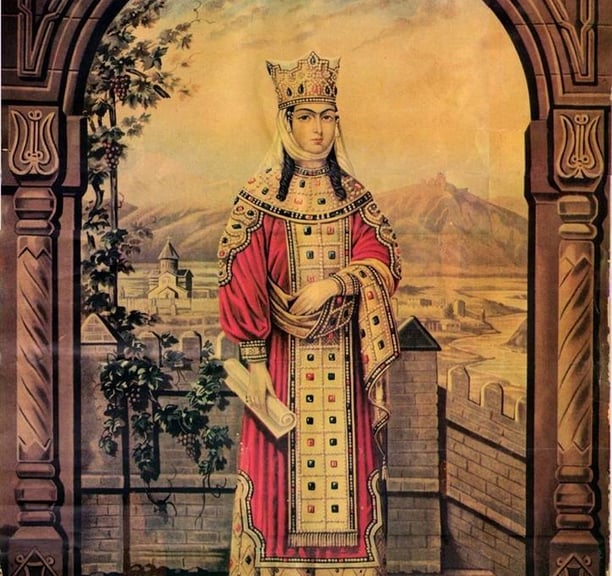

ROYAL FAMILY
The ქართული სამეფო ოჯახი (kartuli samepo ojaxi, Georgian royal family) has played a significant role in the country’s history, shaping its culture, identity, and political landscape for over a thousand years. The most famous dynasty, the ბაგრატიონი (bagrationi, Bagrationi), ruled Georgia from the early Middle Ages until the country was annexed by the რუსეთის იმპერია (rusetis imperia, Russian Empire) in the 19th century. The Bagrationi family is believed to have descended from ancient ბიბლიური მეფეები (bibliuri mepeebi, biblical kings), linking them to a divine and noble heritage. One of the most celebrated rulers was მეფე თამარი (mepe tamari, King Tamar), often referred to as საქართველოს მეფე-დედოფალი (sakartvelos mepe dedopali, King-Queen of Georgia), who led the country into its ოქროს ხანა (okros khana, Golden Age). Today, members of the Bagrationi family still exist, and some have been involved in efforts to restore the monarchy or maintain Georgia’s royal legacy. The family’s history is preserved in გელათის მონასტერი (gelatis monasteri, Gelati Monastery) and მცხეთის სვეტიცხოველი (mtskhetis svetitskhoveli, Svetitskhoveli Cathedral), where generations of Georgian kings are buried.


KHACHAPURI
აჭარული ხაჭაპური (ach’aruli khach’ap’uri, Adjarian khachapuri) is one of the most famous and distinctive variations of ქართული ხაჭაპური (kartuli khach’ap’uri, Georgian khachapuri), originating from the აჭარა (ach’ara, Adjara) region along the შავი ზღვის სანაპირო (shavi zghvis sanapiro, Black Sea coast). Unlike other types of khachapuri, which are typically round or flat, the Adjarian version is shaped like a ნავი (navi, boat), symbolizing the region’s strong maritime culture. The golden-brown dough is filled with melted სულგუნი (sulguni, sulguni cheese), and just before serving, a raw კვერცხის გული (kvertskhis guli, egg yolk) and a generous amount of კარაქი (karaqi, butter) are placed on top, creating a rich and creamy texture. To eat it the traditional way, diners tear off pieces of the crust and dip them into the warm, gooey cheese and egg mixture. Adjarian khachapuri is a staple of ქართულო სამზარეულო (kartuli samzareulo, Georgian cuisine) and a must-try dish for visitors to Batumi and the Adjara region.
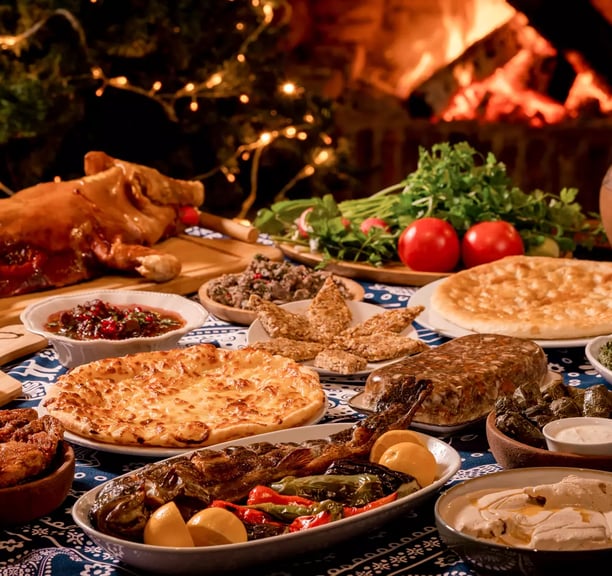

SUPRA
The სუფრა (supra, supra) is one of the most important and cherished traditions in ქართული კულტურა (kartuli kultura, Georgian culture), representing hospitality, unity, and celebration. A supra is a grand ქართველთა წვეულება (kartvelta tsveuleba, Georgian feast), where family and friends gather around a large table filled with traditional dishes such as ხაჭაპური (khach’ap’uri, khachapuri), ხინკალი (khinkali, khinkali), and an array of meat, cheese, and vegetable dishes. The heart of the supra is the თამადა (tamada, toastmaster), a respected person chosen to lead the feast with eloquent and meaningful toasts, often reflecting themes of love, friendship, and Georgian history. Each toast is followed by a drink of ქართული ღვინო (kartuli ghvino, Georgian wine), often made using the ancient ქვევრი ღვინის დაყენება (kvevri ghvinis dagekneba, qvevri winemaking method). There are two main types of supra: the სამგლოვიარო სუფრა (samgloviaro supra, funeral supra), which is more solemn, and the სადღესასწაულო სუფრა (sadghesasts’aulo supra, festive supra), which is lively and full of music, laughter, and dancing.
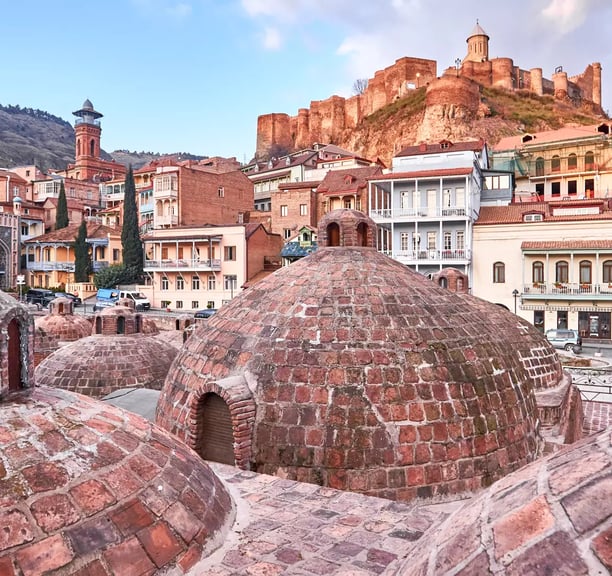

BATHHOUSES
ქართული აბანოები (kartuli abanoebi, Georgian bathhouses) have been an essential part of the country’s culture for centuries, offering both relaxation and health benefits. The most famous are the თბილისის გოგირდის აბანოები (tbilisis gogirdis abanoebi, Tbilisi sulfur baths), located in the historic აბანოთუბანი (abanotubani, Abanotubani district), where natural გოგირდიანი წყალი (gogirdiani ts’kali, sulfuric water) flows from underground hot springs. These bathhouses have been visited by historical figures like ალექსანდრე პუშკინი (alek’sandre pushkini, Alexander Pushkin), who praised their rejuvenating effects. The დახურული ოთახები (dakhuruli otakh’ebi, private rooms) in the bathhouses offer a traditional კეძო მასაჟი (k’edzo masaji, kisa massage), an exfoliating scrub using a coarse cloth to cleanse and refresh the skin. Georgian bathhouses are not just places for personal care but also centers for სოციალური შეკრება (socialuri shekreba, social gatherings), where people relax, converse, and conduct business. Beyond Tbilisi, historic bathhouses can be found in ბორჯომი (borjomi, Borjomi) and ცხინვალი (tskhinvali, Tskhinvali), showcasing the country’s long tradition of using thermal waters.


EXPAND YOUR KNOWLEDGE
If you are interested in learning more about Georgian culture and history as well as the language, we recommend that you download our complete Georgian language course!
You will not only receive all the contents available on our website in convenient pdf or epub formats but also additional contents, including bonus vocabulary, more grammar structures and exclusive cultural insights with additional Georgian vocabulary that you won't find anywhere else.
The additional articles include over 100 words or expressions related to the culture of the Georgian people. Not only will you be able to speak the Georgian language with confidence but you will amaze your listeners thanks to your knowledge of their country and history.
